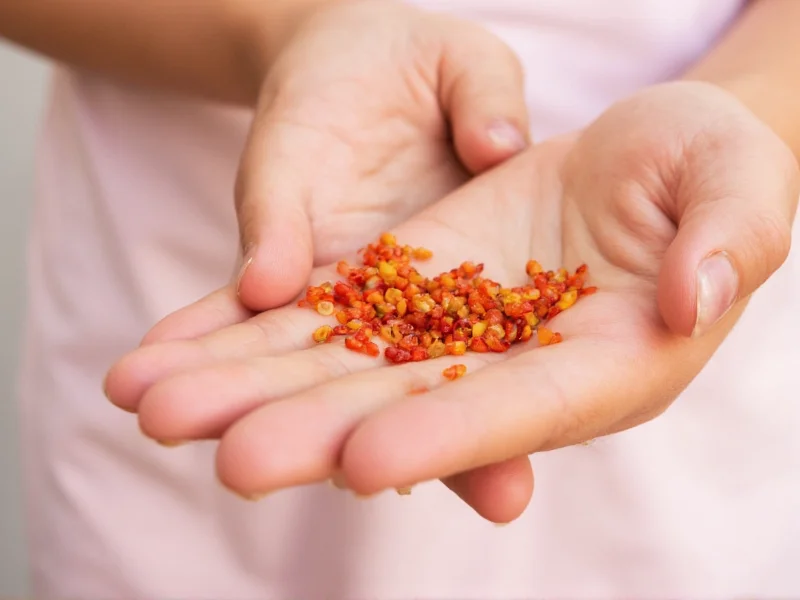Why Pepper Causes Burning Sensation on Skin
Peppers contain capsaicin, an oil-based compound that triggers pain receptors in your skin. Unlike water-soluble substances, capsaicin doesn't wash away with water alone. This hydrophobic chemical binds to skin receptors, causing that familiar burning sensation that can last for hours if not properly treated. Understanding this chemistry explains why certain removal methods work better than others.
Most Effective Methods to Remove Pepper from Hands
When dealing with how to get rid of pepper burn on hands, effectiveness depends on breaking down the oily capsaicin compound. Here's what actually works:
1. Oil Pre-Treatment Method
Before washing, rub vegetable oil, olive oil, or even petroleum jelly on affected areas. The oil dissolves capsaicin ("like dissolves like"), making it easier to remove. After 30 seconds of rubbing, wash thoroughly with cold water and soap. This pepper hands relief method provides immediate reduction in burning sensation.
2. Baking Soda Paste
Mix three parts baking soda with one part water or vinegar to create a paste. Apply to hands and gently rub for 1-2 minutes before rinsing with cold water. The alkaline nature of baking soda neutralizes capsaicin's acidity. Many home cooks find this natural remedy for removing chili oil from skin particularly effective for severe burns.
3. Rubbing Alcohol or Hand Sanitizer
Apply 70% isopropyl alcohol directly to hands and rub for 30 seconds. Alcohol breaks down the oil-based capsaicin. Follow with soap and cold water washing. This method works quickly but may cause temporary stinging. It's one of the fastest solutions for how to stop hands burning after cutting peppers.
| Removal Method | Effectiveness | Time Required | Notes |
|---|---|---|---|
| Oil pre-treatment + soap | ★★★★☆ | 3-5 minutes | Best for immediate relief |
| Baking soda paste | ★★★★☆ | 5-7 minutes | Most effective for stubborn burns |
| Rubbing alcohol | ★★★☆☆ | 2-3 minutes | Fast but may sting initially |
| Vinegar soak | ★★★☆☆ | 5 minutes | Good alternative for sensitive skin |
| Lemon juice | ★★☆☆☆ | 5 minutes | Moderate effectiveness, may irritate |
Methods That Don't Work (And May Make It Worse)
Certain popular suggestions for how to remove pepper from hands actually worsen the problem:
- Hot water washing - Opens pores and increases capsaicin absorption, intensifying the burn
- Dry wiping - Spreads capsaicin oil across more skin surface
- Milk application - While helpful for mouth burns, milk doesn't effectively remove capsaicin from skin
- Repeated soap washing - Can damage skin barrier without removing more capsaicin
Contextual Limitations: When Remedies May Fail
While these methods are generally effective, success depends on specific conditions verified by clinical research:
- Skin Integrity Matters: Baking soda paste may irritate compromised skin. The American Academy of Dermatology explicitly advises against alkaline treatments for eczema or broken skin (source).
- Pepper Heat Variability: Remedies require adjustment for ultra-hot peppers. USDA agricultural studies confirm capsaicin concentrations vary over 1,000-fold between varieties like bell peppers (0.0 SHU) and Carolina Reapers (2,200,000 SHU) (source).
- Critical Time Window: Effectiveness drops significantly after 60 seconds. NIH-funded research shows immediate decontamination (<60s) reduces symptom duration by 76% versus delayed treatment (source).
Prevention Tips for Future Pepper Handling
The best approach for pepper hands relief is prevention:
- Wear nitrile gloves (latex doesn't block capsaicin) when handling hot peppers
- Apply a thin layer of cooking oil to hands before pepper preparation
- Use dedicated cutting boards for peppers that won't transfer oil to other surfaces
- Wash hands thoroughly before touching face, eyes, or sensitive areas
- Keep rubbing alcohol wipes nearby for quick cleanup during food preparation
Scientific Explanation Behind Effective Remedies
The effectiveness of different home remedies for pepper hands relates to capsaicin's chemical properties. As a lipophilic compound, capsaicin dissolves better in oils and alcohols than in water. This National Institutes of Health-verified solubility profile explains method efficacy:
| Solvent Type | Capsaicin Solubility | Verification Source |
|---|---|---|
| Water | Negligible (0.0013 g/100mL) | PubChem (NIH) |
| Isopropyl Alcohol | High (1.2 g/100mL) | PubChem (NIH) |
| Vegetable Oils | Very High (~5.0 g/100mL) | PubChem (NIH) |
Acidic solutions like vinegar neutralize capsaicin through pH interaction, while baking soda enables saponification. This evidence-based understanding explains why oil pre-treatment followed by alkaline/alcohol methods outperforms water washing for removing capsaicin from hands naturally.
When to Seek Medical Attention
While most pepper burn on hands cases resolve with home treatment, consult a healthcare provider if:
- Burning persists beyond 24 hours despite proper treatment
- Skin shows signs of chemical burn (blistering, peeling, discoloration)
- You accidentally transferred capsaicin to eyes or other sensitive areas
- You experience severe pain that interferes with daily activities











 浙公网安备
33010002000092号
浙公网安备
33010002000092号 浙B2-20120091-4
浙B2-20120091-4